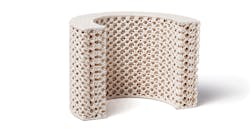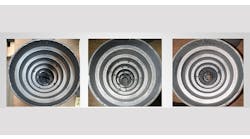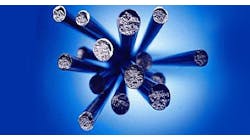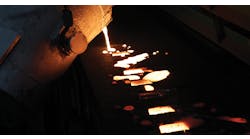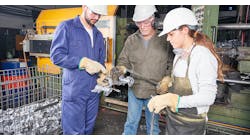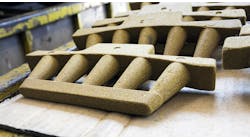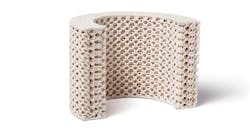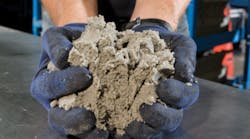Q Inorganic binders appear to be receiving more publicity recently. My understanding, though, was that they provided environmental benefits, and yet, when it came to performance they couldn’t meet expectations. Is that correct? What is the truth behind inorganics?A The truth about inorganics is two-folded. At one time, environmental benefits were practically their only featured benefit. However, through extensive R&D efforts, superior inorganics have emerged allowing for higher performance that exceeds even that of cold box technology.
The story of inorganic binder chemistry generally begins in 2003 with its introduction at GIFA – the world’s largest foundry tradeshow. There, as stated, inorganic binders were marketed as the environmentally friendly option to cold box coremaking. As one may suspect, cold box binder systems had a reputation for high emissions. Thus, in typical “technology push” fashion, researchers sought first entry into this somewhat debated niche position. Ultimately, though, inorganics were correctly and accurately positioned.
Inorganic technology (silicate-based core technology) emits practically no harmful emissions, an enticingly “new” characteristic in the field of binder chemistry. As one could imagine, interest peaked. With this process, elaborate exhaust systems and air purification measures were no longer needed. Despite this, expectations were disappointed by substandard performance. Ultimately, the earliest forms of inorganics had difficulties with core stability and sand adhesion resulting in the inability to properly accommodate large-scale production.
In 2007 inorganics experienced a major reemergence through continuous development efforts across the industry. Issues such as, inadequate flow and sand adhesions were now being focused on directly by research and development teams.
Advances in simulation, in particular, dealt specifically with sand compaction issues. Formerly, complex core geometries (e.g. water jackets) were very difficult to create with uniform strength integrity. Now, however, simulation software, such as Arena-Flow® (computation particle fluid dynamics), have improved sand flow and compaction issues significantly. Furthermore, research and development efforts have also led to the creation of a mineral-based additive promoter to improve removal strength, improve surface finish, and improve deformation stability. In the end, the properties that once plagued inorganics are now becoming major strengths.
|
|
Binder System |
|
|
|
Cold Box |
INOTEC™ |
|
Solidification time in minutes |
6 |
5.5 |
|
Casts without cleaning |
15 |
257 |
|
Cleaning effort within 24 hr. in min. |
320 |
20 |
|
Cast output in pieces/hr. |
7.8 |
10.8 |
In order to properly convey the current state of inorganics, specifically ASK Chemicals’ high-performance INOTEC™ binder system, we have provided productivity gain data, based on actual mass production usage (see Table 1). In this example, a cast piece, or core, for a 6-cylinder diesel engine, was produced. The data depicted represents figures based on the two technologies used.
While a cast piece produced conventionally using the cold box method required about 6 minutes of solidification, the base plate temperature of the ingot mold, favored by the lack of condensate, was reduced when using INOTEC, with the results that the finished cast part was removed after 5.5 minutes. For clarification sake, the specific reason INOTEC's cycle time fell shorter than cold box was because of its ability to reduce the temperatures of the permanent mold in the ground plate. With cold box, the temperature decrease is limited due to the formation of tar, which results in prolonged cleaning downtimes. Greater productivity and performance, as shown in the INOTEC example, resulted in maximum production potential with limited constraints. This is, in fact, why INOTEC is considered to be a door opener to new technological advancements.
The productivity results found in the example were startling on another level. The cold box system required cleaning of the ingot mold after just 15 casts. The INOTEC system, however, could literally run a 24-hour shift without a single cleaning! Thus, in theory, INOTEC would allow for uninterrupted production to exist for an entire work cycle. Cleaning of the ingot mold could simply commence after production, allowing for no lapses.
Additional benefits of the INOTEC inorganic system were also noticed: reduced porosity, better breaking elongation and greater tensile strength values. Furthermore, higher values in the alternate bending test were seen that suggests higher load strength. This, in turn, opens up new perspectives in regard to the reduction of wall thicknesses and is therefore a further step toward downsizing and the development of more powerful engines with lower emissions at the same time.
Inorganic binder technology should ultimately no longer be viewed solely as an environmental option to cold box. Rather, as the aforementioned results and history indicate, inorganics are arguably a higher performing option, as well.
Join the Conversation. Email Your Questions for ASK ChemicalsShare your insights, opinions, and elaborate on the questions and the experts' answer(s). You must be logged in to the website in order to post your comments.
